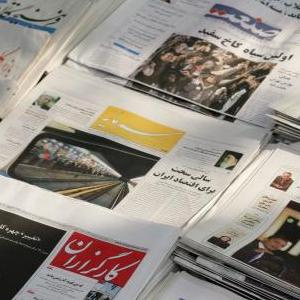Tehran’s Daily Newspapers’ Review

Hamshahri
Economic Recession Aggravated: Industries and Production Centers under the Pressure of Electricity Shortage
After a 4-Month Delay: Majlis [the Iranian Parliament] probing the government’s delay in paying [Tehran’s] metro credit
Iran
Parliament’s Bill Ratified by the Council of Guardians; in Three Years: [Cities’ and villages’] Councils’ elections to be held [simultaneously] with the 11th presidential [election]
President [Ahmadinejad] at the Convention of Provinces’ Students’ Basij: “We should not draw a circle around ourselves which excludes the majority of people.”
Jomhouri-ye Eslami
U.S. Senior Commander in Iraq: We will stay in Iraq for another ten years
With a Demonstration on the Anniversary of Goharshad Mosque’s Cannonade (1): Mashhad women call for battle against the mal-Hijab (2) phenomenon in society
El Baradei Banned from Entering Universities in Egypt
Kayhan
Supreme Leader of the Revolution in Meeting with Officials and People: 31 years of American Conspiracy Have Strengthened Iran
Fifteenth Anniversary of Bosnian Muslims’ Genocide: Germany and France Played a Part
The Massive Demonstration of Hijab and Decency in Mashhad
Khabar
What Has the Highest Ranking Cultural Institution of the Country Done to Meet the Leadership’s Demands: Question mark in front of Council of Cultural Revolution’s Record
Of the 26 Responsible Institutions: Only the Ministry of Culture has offered plans for Decency and Hijab
Mohsen Rezayi Talks About Hashemi and the Future of Principlists and Reformists
Resalat
Habibollah Asgar-Oladi [Principlist Politician] in an Interview with Mehr [News Agency]: Principlists Revise Their Dialogue Language
Supreme Leader of the Revolution in Meeting with Heads of the Vali-e Faqih’s (3) Representation Institutions in the Universities: Scientific Progress Is the Reality of Academic Environments
Shargh
Council of Guardians’ Approval of Simultaneous Council and Presidential Elections: No elections this year
[Parliament Spokesman] Ali Larijani States: Powers Should Be Honest with the Leadership
Tehran-e Emrooz
Iran’s Allies in the Vienna Group
Minister of Culture: No permission for Los Angeles singers (4)
Approval Stamp on Simultaneous Elections
Vatan-e Emrooz
How did the Catalanization Process of Spain’s National Team Lead to the Championship?: The [World] Cup under the shadow of Catalans
Vatan-e Emrooz’ Prediction Realized: Musavi and Karroubi’s betraying stance against the [nuclear] sanctions
(1) On July 12, 1934, the infantry of Reza Shah’s Army opened fire on the people of Mashhad, who had gathered at Imam Reza’s (the eighth Shi’a Imam) Shrine to protest the mandatory new dress code ordered by the Shah of Iran following his modernization campaign.
(2) Hijab is the female dress code suggested in Islam, according to which women should fully cover their head and body. Covering the hands and feet is optional.
(3) Velayat-e Faqih (Guardianship of the Islamic Jurist) was the theory first introduced by Ayatollah Khomeini in the early 1960s. Based on his theory, in the era of Emam Mahdi’s (AS) absence, ruling the Muslim society is assigned to the Faqihs (Islamic Jurists). Based on the Iranian Constitution, the most qualified Faqih should be elected as the Supreme Leader of the Islamic Revolution. The person in this position is known as Vali-e Faqih.
(4) Los Angeles has been the residence of most Iranian pop singers whose music was banned after the Islamic Revolution.
Briefing
Hamshahri (citizen) is the official daily newspaper of Tehran’s Municipality. Its general directions in politics, culture and economy are determined by the mayor of Tehran, currently Mohammad Baqer Qalibaf.
Iran is the official organ of the administration.
Jomhuri-ye Eslami (The Islamic Republic) was known as the official organ of the Party of the Islamic Republic, founded in 1979 and disbanded in 1987. Currently, it is an open critique of Mahmoud Ahmadinejad’s policies and is known to be a mouthpiece of Akbar Hashemi Rafsanjani.
Kayhan (Universe) is a hard-line conservative newspaper. Its editor-in-chief –currently Hossein Shari’atmadari- is appointed by Iran’s Supreme Leader. Shari’atmadari’s editorials often spark off controversy and debate inside Iranian political circles.
Khabar (News) is a principlist daily newspaper which adopts a critical stance towards Ahmadinejad’s policies.
Resalat (Mission) belongs to the moderate wing of the principlist camp. Resalat’s best known anlayst is Amir Mohebbian, its political editor.
Tehran-e Emrooz (Tehran Today) is a ‘principlist reformist’ newspaper, connected to Mohammad Baqer Qalibaf.
Shargh (East) is a moderate reformist newspaper. It was the most popular and influential reformist newspaper in its first period of publication which lasted from August 2003 until September 2006.
Vatan-e Emrooz (Motherland Today) -which started its publication in November 2008-, belongs to Mehrdad Bazrpash, the thirty-old pro-Ahmadinejad politician who is also head of Iran’s second largest auto manufacturer company, Saipa. Vatan-e Emrooz is a supporter of the president’s policies.

